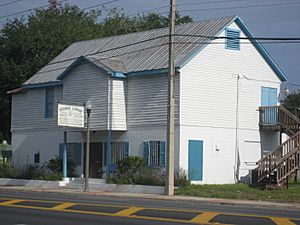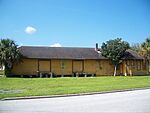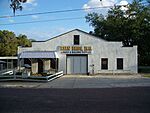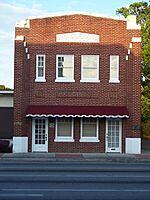Apopka, Florida facts for kids
Quick facts for kids
Apopka
|
|||
|---|---|---|---|
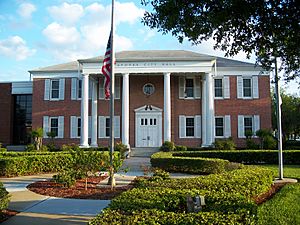
Apopka City Hall in April 2007
|
|||
|
|||
| Nickname(s):
Indoor Foliage Capital of the World
|
|||

Location of Apopka in Orange County, Florida.
|
|||
| Country | United States | ||
| State | Florida | ||
| County | Orange | ||
| Incorporated (Town of Apopka City) |
1882 | ||
| Incorporated (City of Apopka) |
1919 | ||
| Government | |||
| • Type | Mayor–Commission | ||
| Area | |||
| • Total | 35.97 sq mi (93.17 km2) | ||
| • Land | 34.59 sq mi (89.60 km2) | ||
| • Water | 1.38 sq mi (3.58 km2) 4.07% | ||
| Elevation | 82 ft (25 m) | ||
| Population
(2020)
|
|||
| • Total | 54,873 | ||
| • Density | 1,586.25/sq mi (612.44/km2) | ||
| Demonym(s) | Apopkan | ||
| Time zone | UTC−5 (EST) | ||
| • Summer (DST) | UTC−4 (EDT) | ||
| ZIP codes |
32703, 32704, 32712
|
||
| Area codes | 321, 407, 689 | ||
| FIPS code | 12-01700 | ||
| GNIS feature ID | 2403103 | ||
Apopka is a city located in Orange County, Florida. In 2020, about 54,873 people lived there. It is part of the larger Orlando area. The name Apopka comes from the Seminole word Ahapopka, which means "potato-eating place."
Apopka is often called the "Indoor Foliage Capital of the World." This is because there are many greenhouse nurseries in the area that grow plants for indoors.
Contents
History of Apopka
Early Inhabitants and Native American History
The first people known to live in the Apopka area were the Acuera people. They were part of the Timucua group. Sadly, they disappeared by 1730, likely due to diseases brought by Spanish settlers.
Later, people from Alabama and Georgia came to the area. They formed the new Seminole Indian tribe. They called the place Ahapopka, meaning "Potato eating place." By the 1830s, about 200 Seminole people lived here. It was also the birthplace of a famous chief named Coacoochee, also known as "Wild Cat."
After the Second Seminole War, a law called the Armed Occupation Act of 1842 was passed. This law made the remaining native people leave their village and find safety deeper in Florida's wilderness.
American Settlers and Growth
Early American settlers built a big trading center where the Native American village used to be. By 1857, there were enough people to start a Masonic lodge. In 1859, this lodge built a permanent meeting place. This building is now at the corner of Main Street (U.S. Highway 441) and Alabama Avenue.
The settlers near "The Lodge" were mostly on their own during the American Civil War. But after the war, the area grew quickly. This was especially true after railroad lines were built through the region.
In 1869, the Apopka Post Office opened, making it easier to send and receive mail.
Becoming a Town and City
In 1882, the area around "The Lodge" was officially made into a town. It was named "Town of Apopka City." In the 1890s, the town's size actually got smaller because of tough economic times.
In 1905, the Apopka City Council decided to create the Apopka Water, Light, and Ice Company. However, it wasn't until 1914 that voters approved money for a power plant. So, electricity finally came to the city on February 10, 1915. This company later joined with bigger utility companies.
Historic Buildings in Apopka
Five buildings in Apopka are listed on the U.S. National Register of Historic Places. This means they are important historical sites. The Museum of the Apopkans helps to preserve their history.
Apopka Today
Apopka is known for having one of the longest-serving mayors in the United States. John H. Land was first elected in 1949. He served for over 61 years, with a short break. This made him the longest-serving mayor in Florida and the longest-serving full-time mayor in the U.S. until 2014.
The city has its own police department, the Apopka Police Department. The Orange County Sheriff's Department helps areas just outside the city limits.
In 2014, Joe Kilsheimer became mayor, taking over from John H. Land. Then, in 2018, Bryan Nelson won the election and became the current mayor.
City Development
Apopka is a city that is growing quickly. New stores and businesses are opening, especially north of the city on US 441. Because of this growth, a new hospital, AdventHealth Apopka, opened in 2017.
A major road called the John Land Apopka Expressway (Toll 414) opened in 2009. This helped reduce traffic on US 441. There are also plans to extend this expressway, which will make it easier to travel to places like Disney attractions from Interstate 4. This expansion is expected to be finished by 2023.
Geography and Climate
Apopka is located in Florida, about 16 miles northwest of Downtown Orlando.
The city covers about 35.97 square miles (93.17 square kilometers). Most of this area is land, but about 4% is water.
Climate in Apopka
Apopka has a humid subtropical climate. This means it has hot, humid summers and generally mild winters.
| Climate data for Plymouth 3N, 2002–2015 normals, extremes 2002–present | |||||||||||||
|---|---|---|---|---|---|---|---|---|---|---|---|---|---|
| Month | Jan | Feb | Mar | Apr | May | Jun | Jul | Aug | Sep | Oct | Nov | Dec | Year |
| Record high °F (°C) | 86 (30) |
88 (31) |
92 (33) |
96 (36) |
98 (37) |
100 (38) |
98 (37) |
99 (37) |
97 (36) |
96 (36) |
91 (33) |
87 (31) |
100 (38) |
| Mean daily maximum °F (°C) | 70.2 (21.2) |
72.1 (22.3) |
78.5 (25.8) |
83.4 (28.6) |
88.6 (31.4) |
90.9 (32.7) |
92.0 (33.3) |
92.2 (33.4) |
89.8 (32.1) |
84.8 (29.3) |
76.9 (24.9) |
72.0 (22.2) |
82.6 (28.1) |
| Mean daily minimum °F (°C) | 41.8 (5.4) |
44.3 (6.8) |
50.0 (10.0) |
54.8 (12.7) |
62.5 (16.9) |
69.6 (20.9) |
71.7 (22.1) |
72.3 (22.4) |
69.5 (20.8) |
60.9 (16.1) |
51.1 (10.6) |
45.4 (7.4) |
57.8 (14.3) |
| Record low °F (°C) | 16 (−9) |
19 (−7) |
26 (−3) |
30 (−1) |
45 (7) |
57 (14) |
65 (18) |
63 (17) |
54 (12) |
32 (0) |
28 (−2) |
15 (−9) |
15 (−9) |
| Average precipitation inches (mm) | 2.51 (64) |
2.56 (65) |
3.01 (76) |
3.02 (77) |
4.03 (102) |
7.95 (202) |
7.15 (182) |
8.36 (212) |
4.75 (121) |
2.80 (71) |
1.47 (37) |
2.71 (69) |
50.32 (1,278) |
| Average rainy days (≥ 0.01 in) | 7.2 | 6.9 | 6.9 | 5.1 | 7.8 | 16.0 | 16.5 | 17.8 | 11.9 | 7.3 | 4.5 | 7.0 | 114.9 |
| Source: NOAA | |||||||||||||
Population of Apopka
| Historical population | |||
|---|---|---|---|
| Census | Pop. | %± | |
| 1890 | 490 | — | |
| 1900 | 218 | −55.5% | |
| 1910 | 410 | 88.1% | |
| 1920 | 798 | 94.6% | |
| 1930 | 1,134 | 42.1% | |
| 1940 | 1,312 | 15.7% | |
| 1950 | 2,254 | 71.8% | |
| 1960 | 3,578 | 58.7% | |
| 1970 | 4,045 | 13.1% | |
| 1980 | 6,019 | 48.8% | |
| 1990 | 13,512 | 124.5% | |
| 2000 | 26,642 | 97.2% | |
| 2010 | 41,542 | 55.9% | |
| 2020 | 54,873 | 32.1% | |
| U.S. Decennial Census | |||
Apopka is a diverse city. In 2020, there were 54,873 people living in Apopka. These people made up 17,312 households and 12,822 families.
Education in Apopka
Apopka has several schools and learning centers:
- Forest Lake Academy: A high school run by the Seventh-day Adventist group.
- Apopka is part of Orange County Public Schools. It has two high schools: Apopka High School and Wekiva High School.
- The University of Florida has a research and education center in Apopka, called the Institute of Food and Agricultural Sciences Mid-Florida Research and Education Center.
- The Golf Academy of America (Altamonte Campus) is a two-year college for golf studies.
- Christian Learning Academy is a private school for students from kindergarten through 12th grade. It offers sports, music, and Model United Nations programs.
Healthcare in Apopka
Apopka has one hospital, called AdventHealth Apopka.
Notable People from Apopka
Many interesting people have connections to Apopka, including:
Automobile Racing
- Fireball Roberts: A famous race car driver.
- Wayne Taylor: An owner of a racing team, Wayne Taylor Racing. He won the 24 Hours of Daytona race in 1996 and 2005.
Baseball
- Ray Goolsby: A war veteran who played baseball for the Washington Senators.
- Zack Greinke: A Baseball All-Star and award-winning pitcher.
Basketball
- Joel Berry II: A basketball player for the University of North Carolina.
- Joe Chealey: A professional basketball player.
Economics
- Glenn Hubbard: The dean of Columbia University Graduate School of Business.
Arts
- Brad Linaweaver: A science fiction writer, film producer, and screenwriter.
Football
- Steve Baylark: A former NFL running back.
- Rogers Beckett Jr.: A former NFL safety.
- Alan Gendreau: A football placekicker.
- Brandon Meriweather: A former NFL defensive back.
- Jalen Carter: A Defensive Tackle for the Philadelphia Eagles.
- Warren Sapp: An All-Pro NFL defensive lineman.
- Sammie Smith: A former NFL running back.
- Renardo Green: A Cornerback for the San Francisco 49ers.
Gaming
- Justin McGrath: A professional Super Smash Bros. Melee player.
Inventor
- Richard Borg: A designer of board games.
Music
- Scott Stapp: A singer and songwriter for the rock band Creed. He grew up in Apopka.
- John Anderson: A country singer.
- Sawyer Brown: A country music band that started in Apopka.
- Jonathan Cain: A musician and songwriter for the rock band Journey. He lives in Apopka.
- Jerry Lawson: The lead singer of The Persuasions.
- Pat Travers: A musician who tours, records, and lives in Apopka.
Boxing, Weightlifting, and Wrestling
- Christy Martin: An American world champion boxer who lived in Apopka for many years.
- Mattie Rogers: An Olympic Weightlifter.
- Monty Sopp: A professional wrestler who used to be with WWF/E.
Apopka in Art and Books
Apopka has been mentioned in several creative works:
Literature
- The city is mentioned in Zora Neale Hurston's famous novel, Their Eyes Were Watching God.
- It's also referenced in Eddie C. Brown's book, Beating the Odds: Eddie Brown's Investing and Life Strategies.
- Books like The Pennings of Perrine Slim: Stories of Northwest Orange County Florida by William Gladden, Jr., and History of Apopka and Northwest Orange County, Florida by Jerrell H Shofner, share more about the area's past.
- Tales of the Big Potato by Jack Christmas and Apopka: Images of America also feature the city.
Film
- Apopka is the setting for the horror drama Masking Threshold, which came out in 2021.
- It's also mentioned in the movie ""Ernest Saves Christmas"" on Ernest's truck, which says "Apopka Snake Ranch."
See also
 In Spanish: Apopka para niños
In Spanish: Apopka para niños




